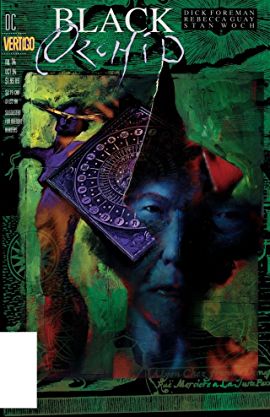Recap #259: Black Orchid #14 – “Glamour’s End” by Dick Foreman and Rebecca Guay
Title: Black Orchid #14 – “Glamour’s End” a.k.a. “Annis Get Your Gun!”
Writer: Dick Foreman
Penciller: Rebecca Guay
Inker: Stan Woch
Colorist: Digital Chameleon
Letterer: Clem Robbins
Editor: Lou Stathis
Assistant Editor: Alex Alonso
Cover Artist: Dave McKean
Summary: In England, Black Orchid encounters a formidable foe who ensares her with a powerful “glamour” spell.
Initial Thoughts
So it feels like I’ve been on creative burnout for I don’t know how long and I’m freaking sick of it. It took me forever to finish a couple of other non-Point Horror related projects, and with this ear infection thing I’ve been dealing with I haven’t had any energy to do anything. I think I’m having a depressive episode and have to get in touch with my therapist.
I’m starting to believe my problem is I’m still expecting too much of myself with this website and am forcing obligation on myself to have stuff prepared for holidays and shit, even if I don’t have the energy or particularly care about a certain book.
That out of the way, I found it’s been easier to focus on minor stuff so I’m doing a recap of one of my favorite issues from one of my favorite titles about one of my favorite heroines.

[Wing: That cover is great. I particularly love her set against the trees and full moon and bats.]
DC’s Black Orchid originally debuted in the 1970s in Adventure Comics, created by Sheldon Mayer and Tony DeZuniga. The first version was a mysterious woman garbed in a purple-and-violet costume whose identity remained unknown to the readers. She had a flair for disguise and spent most of her adventures incognito before bringing the villains to justice. Her calling card was a black orchid flower.
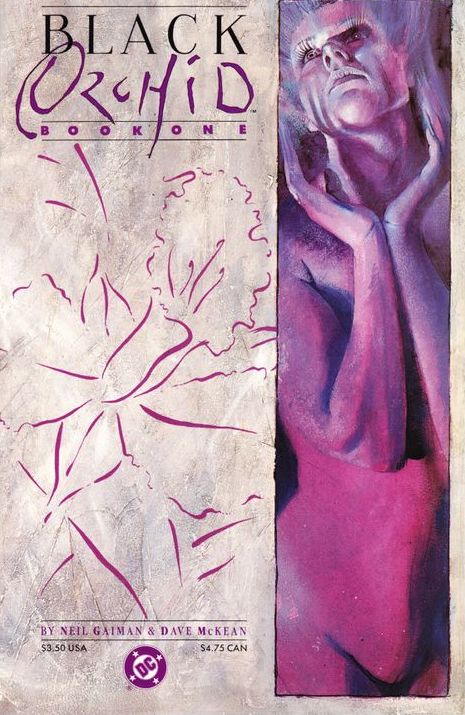
One of Neil Gaiman’s earliest works for DC was a three-issue miniseries (illustrated by Dave McKean) that finally gave Black Orchid a definitive backstory while also killing off the original bearer of the title in the first issue’s opening pages. Gaiman revealed Black Orchid was a plant/human hybrid clone of a woman named Susan Linden-Thorne, murdered by her abusive husband Carl. [Wing: Ah, yes, a good example of why I don’t like Gaiman’s work nearly as much as a lot of people I know.] Black Orchid was created by Susan’s childhood best friend Phillip Sylvian, a scientist who studied botany under Prof. Jason Woodrue alongside Pamela Isley and Alec and Linda Holland. For those unfamiliar with the names, Woodure would turn Pamela Isley into Poison Ivy before he became the Floronic Man, and Swamp Thing was born after the Hollands were murdered. Gaiman basically linked most of DC’s plant-related characters together by having their origins trace back to the same college study group.
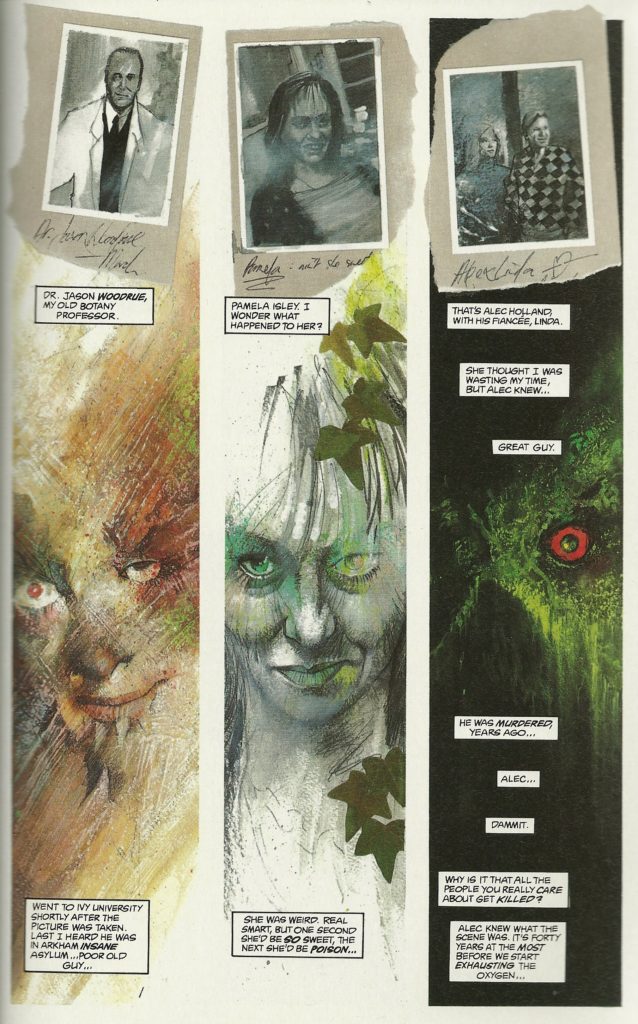
The Black Orchid miniseries focused on the awakening of the original’s “Sister,” who would later take the name “Flora Black.” While Flora struggled to make sense of Susan Thorne’s memories, Carl Thorne returned, murdered Phillip Sylvian, and slaughtered the rest of the dormant hybrid clones. The only survivor of Carl’s massacre was a younger clone that later took on the name “Suzy.”
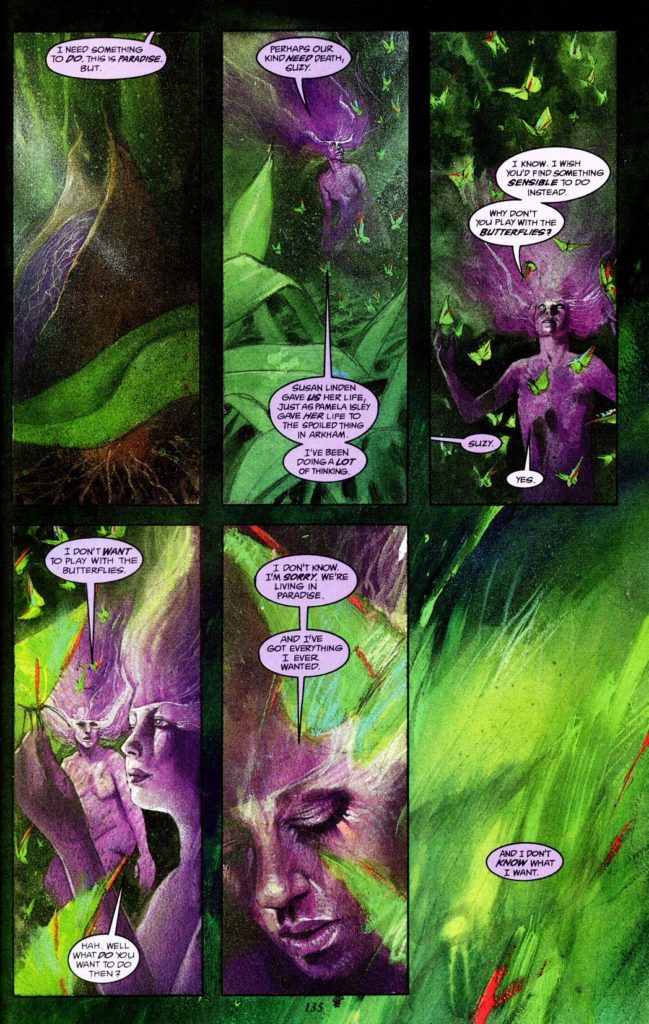
Flora and Suzy set on a path to learn more about who they are, and discovered their origins were more than scientific. The two orchid sisters learned they were a new breed of nymph, a form of dryad born through science, with Flora adopting the “Black Orchid” name and attempting to propagate their race. [Wing: …okay then. Man, comics are weird. This is a huge part of why I love them.]

Following the miniseries, an ongoing title was commissioned under DC’s new Vertigo banner in the early 1990s. The series was written by Dick Foreman and the pencils were handled first by Jill Thompson and then Rebecca Guay. The majority of the Black Orchid comic focused on Flora navigating through life, becoming acquainted with other mystical beings, and trying to stave off the clutches of the sinister Logos Corporation.
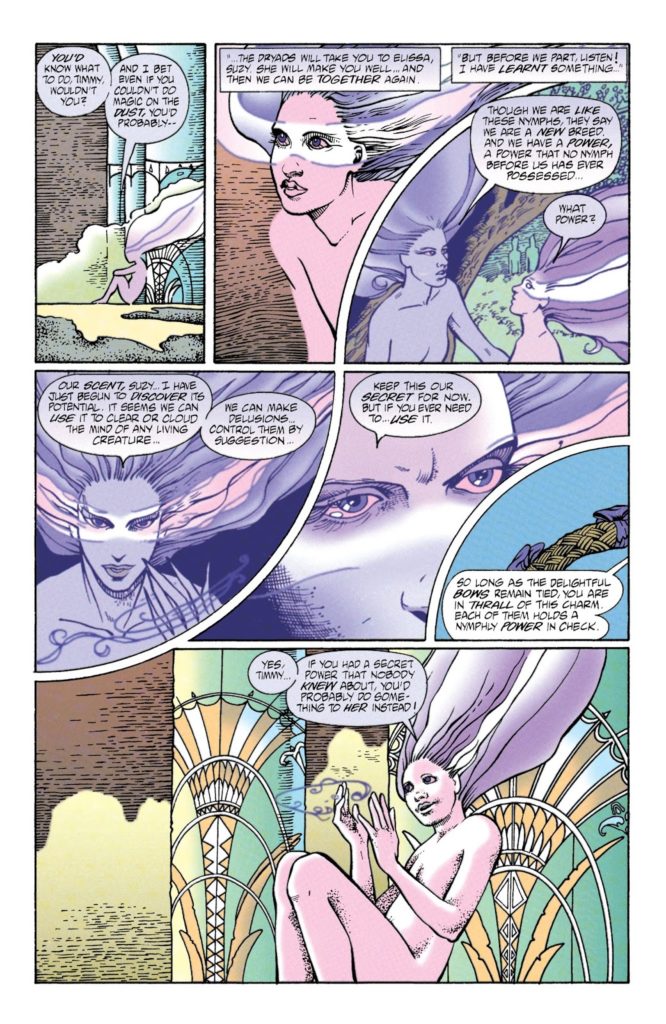
Suzy, meanwhile, had her own journey of self-discovery and even served as one of the main characters in Vertigo’s Children’s Crusade crossover. Her mental journey took her through the realms of Faerie where she hunted after an annoying creep named Junkin Buckley, who sold her out during the Children’s Crusade story. Meanwhile Flora’s mindset and thoughts on humanity darkened following several tragedies. The two Orchids could manipulate pheromones, allowing them to control people or alter their perceptions so they could disguise themselves.
Following the end of Black Orchid, Vertigo and DC barely utilized Flora and Suzy and they were delegated to background characters in several magic-based books like Shadowpact. It still frustrates me to no end that Suzy was thrown into obscurity by the New 52 and replaced by a new Black Orchid, Alba Garcia, who resembled the first version but had absolutely no connection to her three predecessors at all. I-I know it’s nothing the character’s done, but every time I think of her I think of all that wasted potential Suzy had and it makes me… *disgusted groan*
“Glamour’s End” admittedly takes place in the second half of the series, but is one of my favorite issues and works as a stand alone recap since it primarily focuses on Flora battling Black Annis, a British boogeywoman. This isn’t the first time DC and Vertigo have featured a character based on the Black Annis myth. Crazy Jane of the Doom Patrol had a split personality based on her and it was one of her personalities that frequently manifested.
Overall, this issue offers an interesting look at what happens when myths begin to fade away the longer they’re around and can surprisingly make us feel a bit of sympathy for someone that is admittedly a monster.
Summary
On a bus to London, a woman stirs from a long sleep. She doesn’t know who she is, where she’s from, or where she’s going. She doesn’t remember getting on the bus, and the driver informs her the bus departed from the town of Graftonside. The name doesn’t ring any bells, nor does the mention of the “aunt” who put her on the bus in the first place. Whatever’s going on with this woman, she balks the moment the station manager mentions contacting the police and runs away.
Whoever or whatever is responsible for this woman’s predicament seems rather proud of themselves, narrating how she’s been taught a lesson…
Oh yes, my duck. You’ll be waking up by now… waking up in Lud’s town. Heard tell it’s changed some since I last passed through, but I’m sure you’ll have a fine old time.
Chances are you’ll end up in an “institution.” That’s what they’re calling bedlams, nowadays… “Institutions for the mentally ill.”
Ha! So, like I told you… best keep away from the boys in blue!
Not that you’ll remember me telling you, you hoity-toity, jumped-up little trollop…
Not that you’ll remember anything for… ooh, such a long time!
And then it’ll be far too late, it will!
I’ll have learned you your lesson.
And I’ll be one again… one with Anna… past all the grinding and pain…
All one in the ocean of She.
The woman stumbles through a park and collapses to her knees by a pond, lost in her own reflection. Nearby, a man sees her and starts to smirk. He approaches her, claiming to be a friend even though they’ve never seen each other before. The man says there’s something he recognizes about her, but the woman thinks he’s coming on to her. He asks if something’s happened to her, like if she’s having trouble remembering anything. The woman’s forced to admit, yes, other than knowing she’s a person in this world and can speak its language, everything in her mind is a blank.
It seems this woman has been put under something called a “glamour,” a type of enchantment, and this one’s pretty strong. The man can remove it, though, and he’s probably the only person who can help her with the state she’s in.
The man takes the woman back to an oddly decorated apartment in London and takes out a small vial. The vial contains an ointment, bought in a market from a placed called “Stow-In-The-Wold.” The woman only has to put some over her eyes, and then look in the mirror…
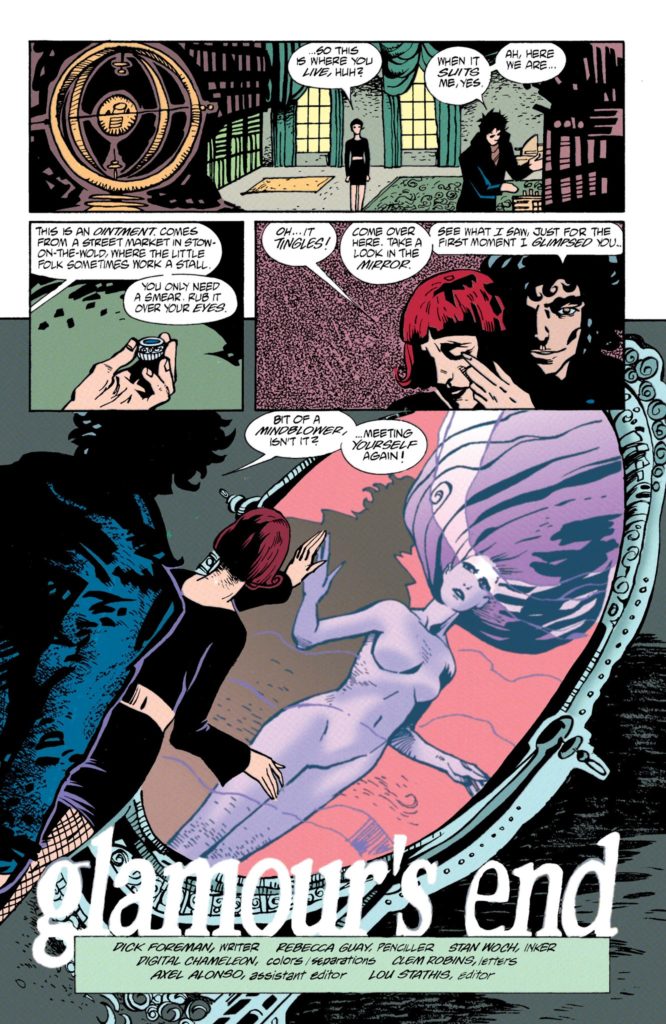
Bam!
The sight of her true reflection undoes the restrictive charm she’s been under, and Flora, the Black Orchid, remembers everything. She remembers coming to England to locate a portal, but stops as she realizes she doesn’t know who this man is or what he wants from her. The man points out he DID just restore her memory, the least Flora can do is tell him what’s going on. Flora concedes, and admits this guy clearly knows a thing or two (like being able to see through her glamour, even for a second) and could be useful to him in the future.
Looking back, Flora explains that it’s her duty as the Black Orchid to restore her kind by planting new seeds to birth more orchid nymphs such as herself and her sister, Suzy. The portal Flora’s been looking for belonged to what is known as a “glaistig,” a type of Scottish nature spirit. The glaistig who lived in Graftonside left and the portal’s been dormant since. Flora wanted to find it and plant her seeds nearby, so when her new children were born they could restore the portal’s connection to the Nexus, the world connecting all metaphyiscal creatures. [Wing: I should have tapped Sister Canary to comment on this. She knows so much more about this mythology than I do.]
Unfortunately, there was someone in Graftonside Flora wasn’t expecting. Upon her arrival she felt their presence, alongside intense feelings of fear and a lingering odor of aniseed. Shadows were made darker, the people cast weary glances on strangers, and the newspapers had warnings about a fake social worker kidnapping children. Flora intended to find whoever this was, but the presence found Flora first.
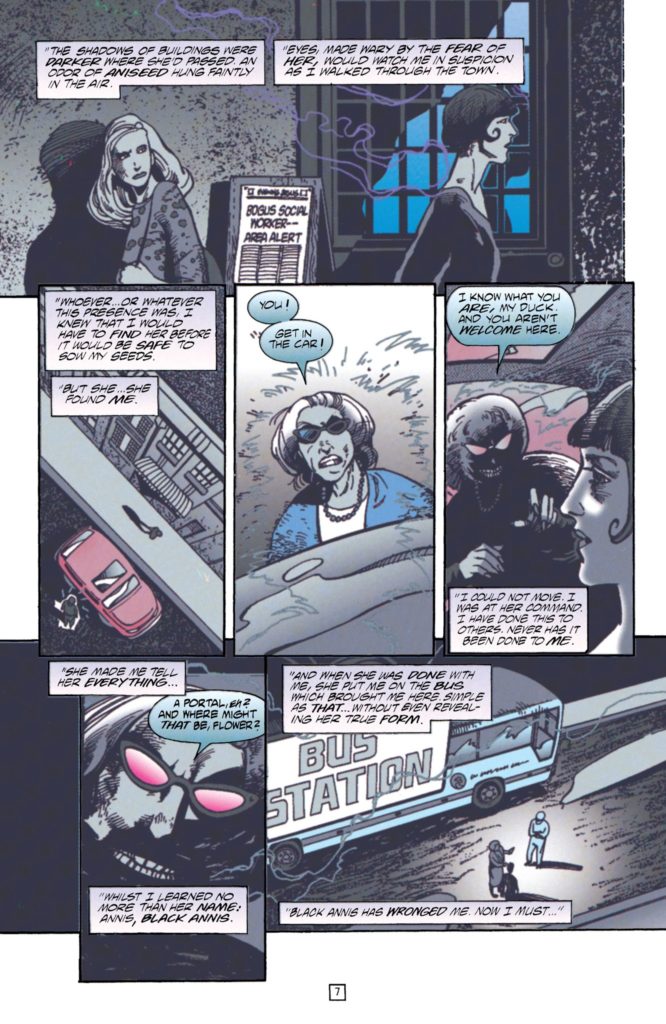
An older, well-groomed woman in dark glasses saw Flora and commanded her to stop. Flora found herself at this woman’s mercy and obeyed. She recognized this type of power, the kind she’s often used to bewitch her enemies. This was the first time anyone ever used it on Flora, and she didn’t like it. [Wing: Shocking, right? Shocking.] The old woman made Flora tell her everything, and she was especially keen to learn about the portal’s location. She then programmed Flora to get on the bus, where the issue began. Flora never even saw her real form, but she learned the old woman’s name.
Black Annis.
Well now the Black Orchid’s back and she’s gonna kick that old witch on her annis, lemme tell you!
[Wing: Oh dear god, that was terrible.]
Flora’s savior warns her to dial it down a notch; if she’s gonna go for Black Annis’s head she needs to prepare herself against Annis’s powers. Now it’s time for him to share his life story, since Flora would like to know how this guy’s gained such knowledge on the dark and spooky.
Seems his name’s Relf, Martin Relf. Martin explains he’s been a lucid dreamer ever since he was a child, and in those dreams he’s long since been in contact with a being who may or may not be the lord of death itself. Essentially, Martin acts as a hired hand for this entity, doing jobs for it in the mortal world here and there. He carries out assassinations (dubbed “karma”) and he’s rewarded handsomely for them. Martin is treated like a “friend” and gifted as one does one’s friends. The only time Martin ever questioned his orders did… not go well, to say the least. He doesn’t wanna talk about it.
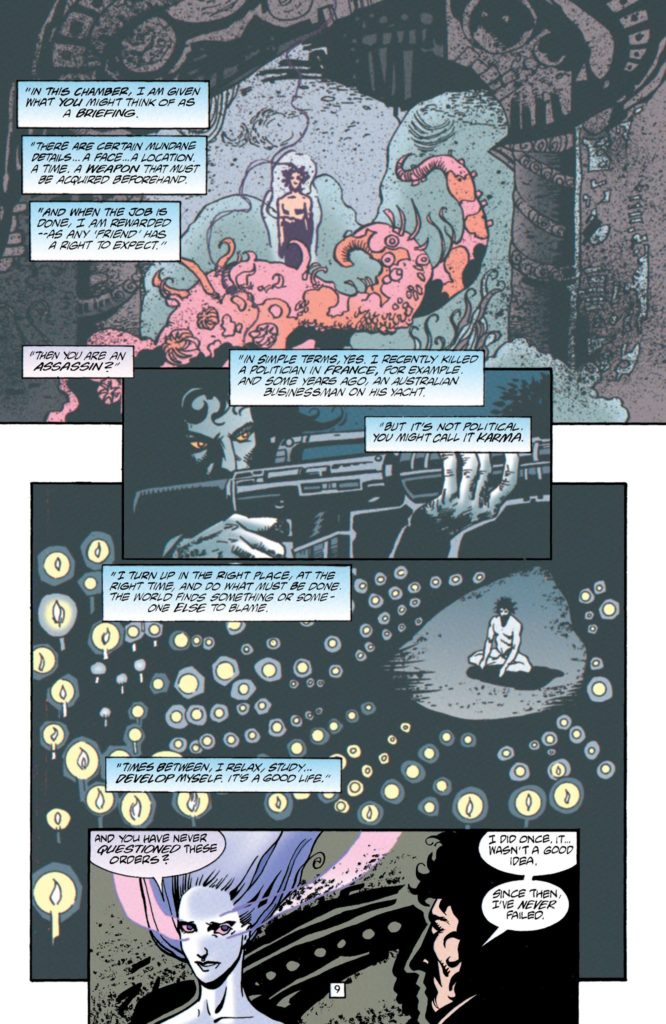
Now that’s taken care of, Martin tells Flora everything he knows about Black Annis. He describes as a blue-skinned hag with claws made of iron. She kidnaps and eats children, and used to live in a cave near Leicestershire. However, those caves are long gone and Martin doesn’t know why Annis wants the portal. Flora’s sure as shit not letting Annis have it. Does calling “dibs” mean nothing anymore, Wing?! [Wing: NOPE.]
Martin gives Flora a jar of an herb called vervain, saying she only needs to put some in a linen pouch and wear it around her neck to prevent Annis from brainwashing her again. As long as Flora doesn’t get too close, mind you. Taking the jar, Flora finds Martin somewhat amusing and then uses her pheromones to make him forget having ever met her.
The moment she’s gone from the room, Martin chuckles at Flora’s cheekiness. Watching her depart from his window, Martin then jots down his little meeting with Flora and offers thanks to the Solemn Duke for such an interesting life.
Meanwhile, a certain cannibal hag is on the hunt and positively giddy at the thought of opening the portal. She’s remembered the ritual, the recipe, for opening it but she’s still trying to remember the words. Annis is so old, you see. Her memory’s not what it used to be. But she knows she’ll need her a babe, and then she won’t have to do all this namby pamby bullshittery anymore.
In her matronly guise, Annis heads for a nearby home and tells the woman of the house she’s from social services. Annis informs this woman of an abuse report and has come to investigate. However, the woman’s not letting Annis in unless she has official papers and such. Oh, and her name ain’t “Smith,” either! Realizing dealing with Black Orchid took too much out of her, Annis is forced to pretend she got the wrong address and departs.
At the next house, Annis has an easier time flustering the woman who answers and is let in. The woman seems terrified at the mention of “abuse complaints,” but dear old Annis assures her it’s probably a misunderstanding. Just let’s have a look at the little man of the house to clear everything up…
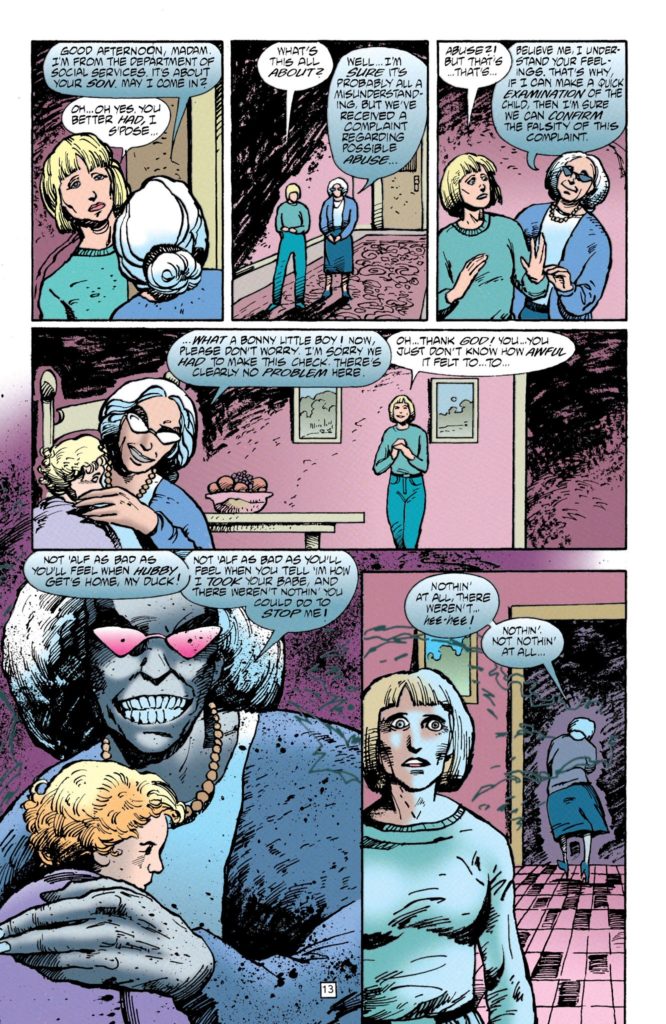
With the baby in her arms, Annis drops some of her disguise and laughs as she leaves the woman in a frozen stupor. Won’t hubby be coming home to a nice surprise?!
Driving off with the stolen baby, Annis thinks about remembering the words and opening the portal to the Nexus. As the car begins to shift and change the closer it gets to the hills, Annis thinks about killing and feasting on the baby so she can reunite with all her other selves, all those aspects she was cut off from so long ago. That way, she’ll be free from time and the pain will stop and she’ll be part of eternity again. All thanks to that trampy little flower girl, her with her “high and mighty ass in the air, what do I care goddess” shtick!
What does a little brat like that possibly know about the world and time?
Now back in her true form, Black Annis flies off with the baby and reaches the hills of Graftonside to the location of the portal. Yet she’s still trying to remember the words, getting mixed up with a children’s song that reminds her of the cave she lost. Energy begins to swarm around her and finally the words come to Annis…
Wikkita wakketa, wikspillit wik goo, tamarind bacon rind, inchy winch stew, bittle and bottle, and piddle and poo, open this gate…
And old Annis is through!
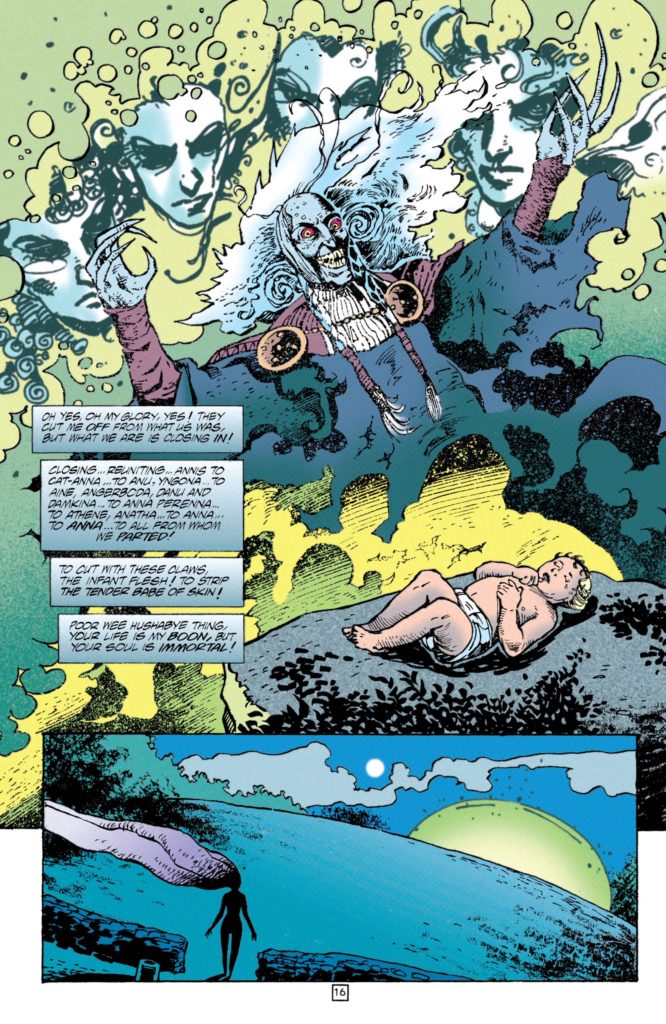
It’s all coming back to Annis, all the other aspects she once joined with when they were part of the same, part of Anna, and now all she has to do is kill the babe and it’ll be done!
Not if Black Orchid has anything to say about it!
Flora swoops in and gets the baby out of harm’s way just as Annis’s claws were about to sink into his neck. Annis howls in rage and demands Flora give the baby back, but Flora’s channeling her late sister’s superhero mojo and declares Black Annis has lost this day. She won’t get the portal and she can’t have the kid. She’s lost!
Yet Flora has no idea what, exactly, has been lost. Annis demands to know if Flora realizes what she’s actually prevented. Little miss Self-Sufficient U.S.A. claims she’s restored balance, but Flora’s done more than that. She’s now completely severed Annis from her source, and Annis is going to die.
Before she dies, Annis manages to get inside Flora’s mind and forces her to see EVERYTHING. She brings Flora back to the beginning, back to the source of all of them. Anna turning the Silver Wheel of Fate, the one from whom they’re all descended. Anna, Annis, Susan, Susanna. All connected, all except Annis. Annis’s link has been severed, and whatever remained of Anna in her mind is gone.
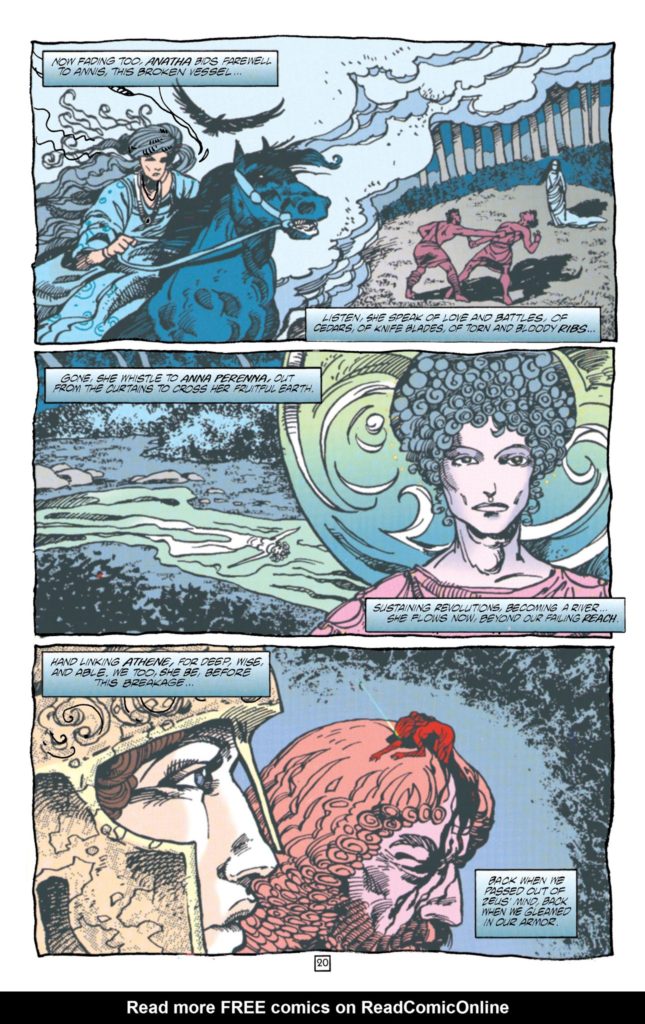
The vessel fading, all others derived from this point of origin, their voices bid her farewell. Anatha, Anna Perenna, Athene, Danu, Aine, Yngona, Anu, Cat-Anna, all the goddesses born from THE goddess… [Wing: I love the litany of the gods who came before.]
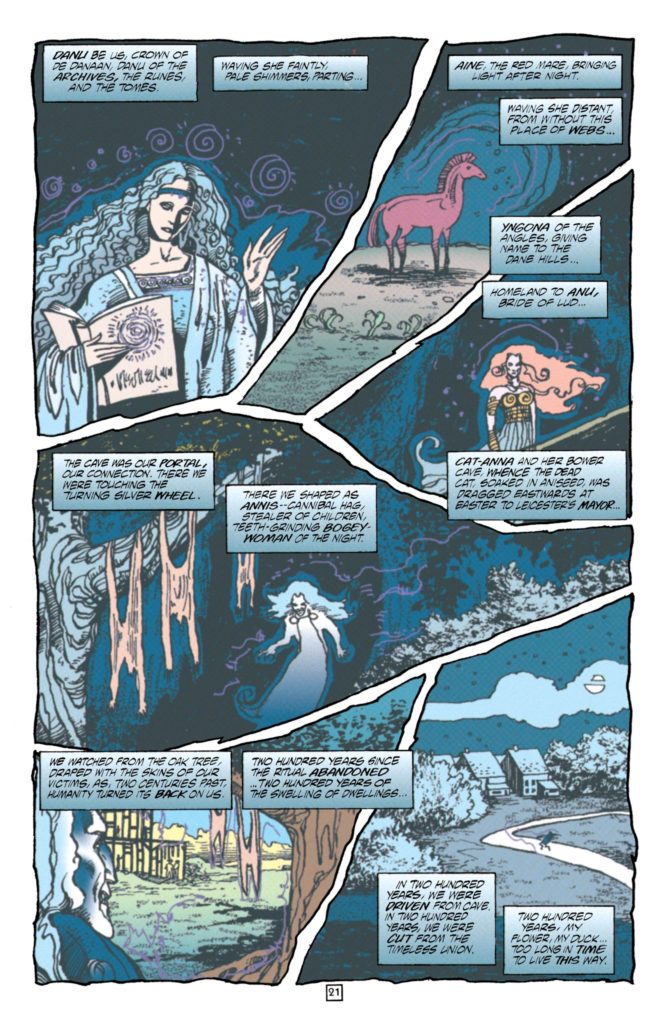
The vessel of Black Annis remembering her birth, her original portal, living in a cave decorated with the skins of her kills. A story used to frighten children. A story forced to watch as society moved on and left the hills, building cities and abandoning the old rituals, abandoning Annis, driving Annis away until she’s nothing…
Flora can only take all this in as a look of realization and genuine terror overcomes her face, clearly understanding what she’s done and regretting it. Annis briefly changes back to her social worker form, a last ditch effort to keep up with the times. This is the new bogey, the idea of the state coming to take away your children, the well-meaning aunts and uncles who only want to help, the social workers of a nanny state that can’t be trusted in this age of media.
Now Annis’s form is breaking faster, eyes gone and skin cracking like porcelain, saying how none of it was enough to stop her from aging. She never had to age before. Never knew pain before. But every day it was some new pain and new crack and new tear and now it all hurts. Her final chance to reconnect and stop it all and the Black Orchid destroyed it. Before she goes, Annis tells Flora this will happen to her soon, it’ll be her’s soon!
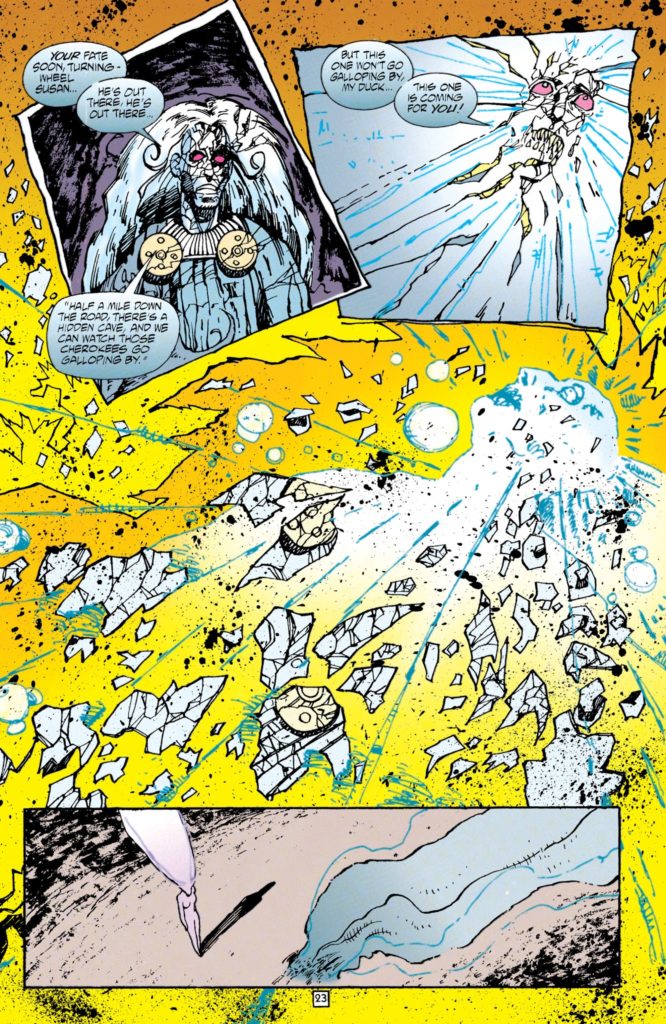
Annis having shattered into nothing, Flora can only stare at the trail of smoke left behind.
From afar, Martin Relf watches through binoculars as Flora flies off to bring the child back to his parents. This was certainly one of the more tidy jobs he’s done, but it looks like he was able to use Flora to get rid of Annis after all.
In Martin’s notes, he says Flora went about seeding the area near the portal, turning it into her grove. Before she left, she made an offering and dedicated the grove to the goddess Anna and to Black Annis. [Wing: It’s a little late for that, Flora.]
Returning to America, all Flora could think of was Annis’s warning.
Final Thoughts
I know that was a lot to come into by reviewing an issue midway through a series, but I felt it offered a lot to talk about in terms of mythology and how we develop sympathy for characters.
First there’s this idea of how myths can be derived from a single point of origin through the way in which a British bogey is connected to the likes of the Greek Goddess of Wisdom or the Roman Goddess of the Year. All of them derived from the same figure based on the constructions of their names. A single woman with multiple faces and facets.
Black Annis is by all accounts and purposes an antagonistic character. She’s a figure from folklore used to scare children into behaving and she basically eats kids and hangs their skins up in her cave. She’s a warning for people to get inside their homes before it gets dark outside. So logically, we know such a character cannot succeed in her goals if it involves stealing and murdering an innocent baby.
However, Annis was created explicitly because people wanted something to scare their kids with. She’s an aspect of the goddess born only to be a monster, and is simply doing as she was programmed to do. Even though society outgrew her, that didn’t mean Annis was gone. No, she was cast aside but Annis managed to survive. Think of the cruelty in creating someone to be a monster and then abandoning them once they’re no longer needed. This wasn’t even done with any genuine malice towards the figure in question, but now what is she to do. Annis tries to adapt to meet with the times since she can’t rejoin with all the other aspects of her source, and her one chance at doing so gets thwarted by an outsider.
Annis is a villain, but it’s not like she had a choice in being one did she?
This has been on my mind a lot ever since I got into a discussion about DC’s overhyped trash hit Watchmen, and how I couldn’t even finish reading it because all of its characters were so boring and unlikable. Someone pointed out how that might’ve been the point and what it says about us only having sympathy for people we feel deserve it because we like them. Yet a story like this shows yeah, you can feel sympathy for someone whose actions are horrible and who is unlikable. So yeah, maybe Watchmen is just a bad story regardless and it even failed in the idea of getting people to sympathize with characters despite not liking them. I dunno. Maybe the struggles of a cannibal crone were more intriguing than an egomaniac smurf or a date rapist soldier for hire in a gimp mask.
[Wing: Definitely should have tagged Sister Canary in on this one (she could make her site debut!) because she was recommending this to me just a couple weeks ago. I haven’t watched it yet (or the movie before), and it’s been years since I read the comic (introduced to me by Raven, actually), so I can’t really respond here, but I will be going into the show with an eye to whether it is or is not pulling off this sort of sympathy for the terrible.]
There’s also the bitter irony in the idea this child stealing monster takes on the form not of an abusive parent or adult, but a social worker, an individual who is supposed to help children. This idea the media has warped the perception of people who are supposed to have the best interests of a child instead becomes a monster who takes them away from their families. And thus the fear leads to the creation of the monster, who then strengthens the fear that created it, and so on.
Annis did indeed predict Flora’s demise, but I can’t say anymore about how or why it happens in case I decide to recap the rest of the series.

